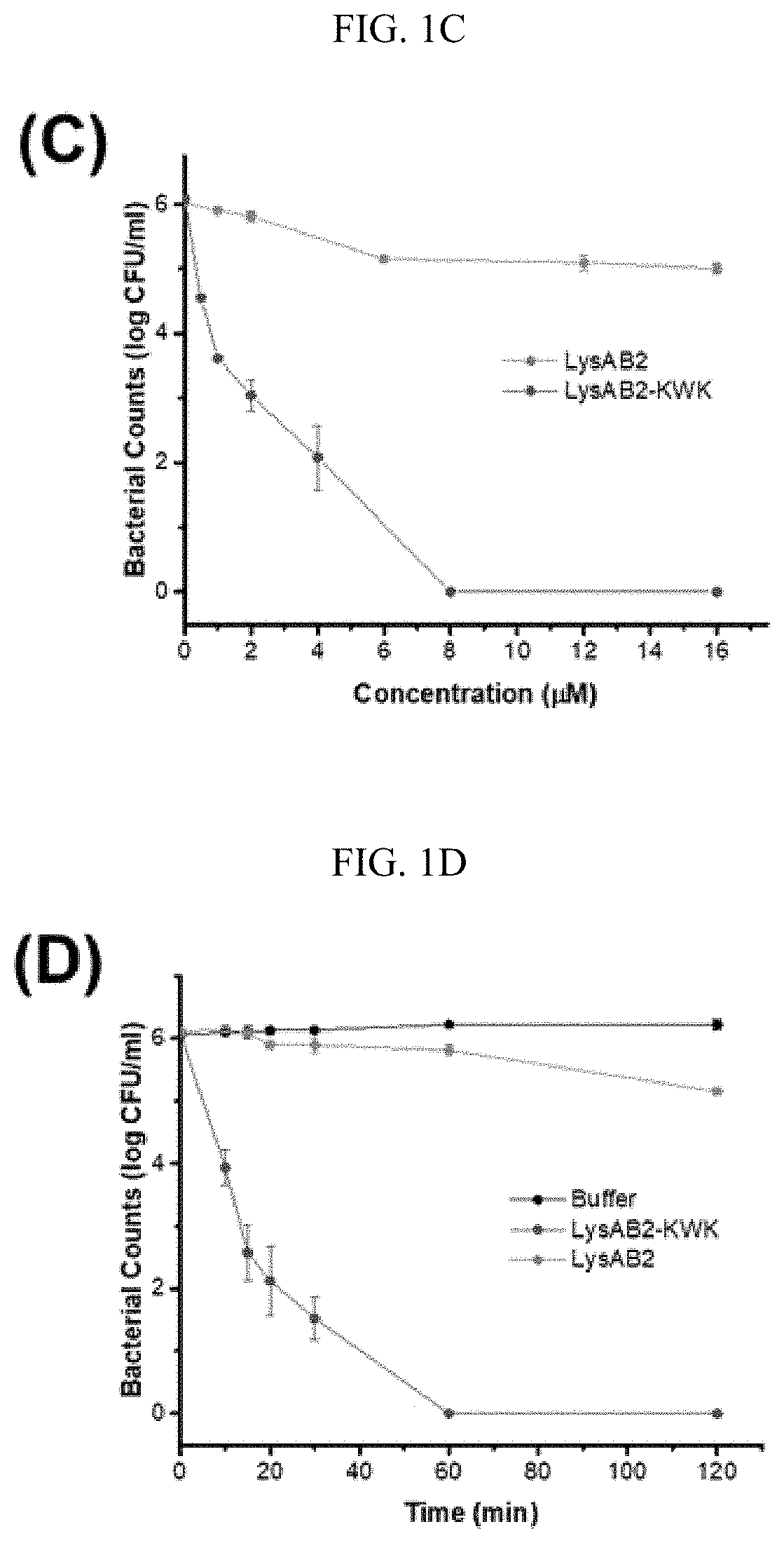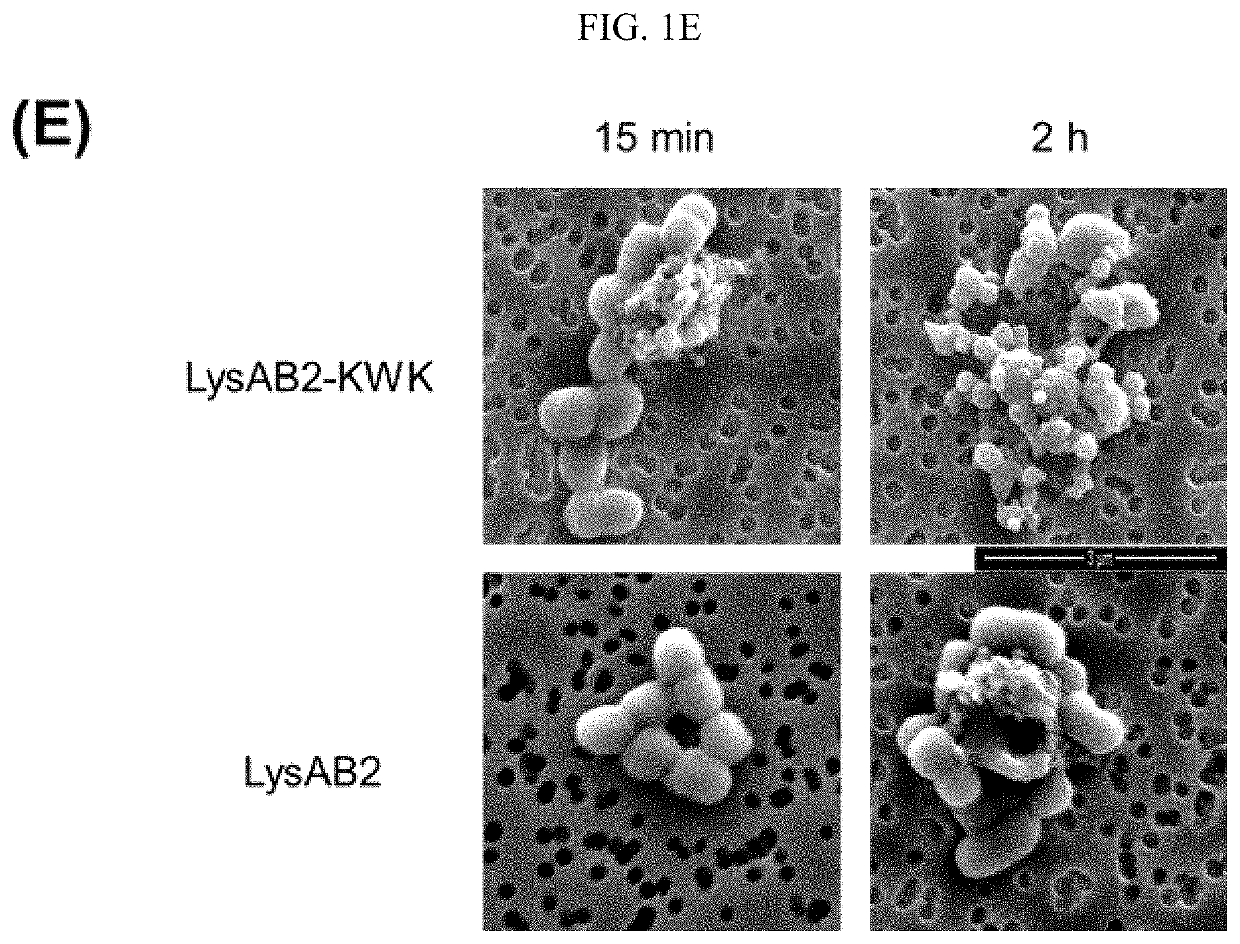Engineered globular endolysin, a highly potent antibacterial enzyme for multidrug resistant gram-negative bacteria
- Summary
- Abstract
- Description
- Claims
- Application Information
AI Technical Summary
Benefits of technology
Problems solved by technology
Method used
Image
Examples
example 1 -
Example 1-Engineering the C-Terminus of LysAB2
[0116]LysAB2 has only modest antibacterial activity that it could cause up to 2-log reduction of the bacterial counts at a concentration of 20 μM, but it was active against a number of Gram-negative and Gram-positive bacteria, including A. baumannii, Escherichia co / i and Streptococcus sanguis [20]. The positively-charged CeA peptide residues 1-8, KWKLFKKI (SEQ ID NO: 1), has been reported to enhance the antibacterial activity of a modular lysin [19]. Two modified LysAB2 constructs were obtained by fusing the CeA peptide octamer at either the C-terminus or the N-terminus of LysAB2 to give an N-terminal fusion construct (KWK-LysAB2) and a C-terminal fusion construct (LysAB2-KWK) (FIG. 1A). Both proteins were expressed and purified, and their antibacterial activities against a multidrug resistant A. baumannii strain, MDR-AB2, at the log phase were compared together with the native lysin. LysAB2-KWK at a concentration of 8 μM completely erad...
example 3 -
Example 3-Serum Activity, Cytotoxicity and Storage Stability
[0121]The practical use of the antibacterial enzymes has requirements beyond antimicrobial activity, such as, for example, serum activity, cytotoxicity towards human cells, and storage stability. Intolerance to serum is well documented for lysins with intrinsic outer membrane penetrating capabilities, significantly limiting their clinical applicability [19,29,30,31]. A hypothesis is that the existence of negatively charged molecules in the serum neutralize the positive charges in the C-terminals of the lysins, resulting in activity loss [19]. To fully evaluate the therapeutic potential of the modified LysAB2-KWK, we tested its activity against A. baumannii in the presence of human serum. Interestingly, the native LysAB2 was completely inhibited in the presence of 1% serum, but LysAB2-KWK could retain some of its activity in a buffer containing up to 4% serum despite the positively charged CeA peptide (FIG. 4A). These findin...
example 4 -
Example 4-Mechanism of the Enhanced Antibacterial Activity
[0124]Although it is hypothesized that the extended positively charge peptide can enhance the outer membrane penetration of modified lysins to improve the bacterial killing efficiency, no experimental evidence was available in the literature. Therefore, the underlying mechanisms responsible for the superior antibacterial activity of LysAB2-KWK were investigated in detail. Frist, we determined whether the CeA peptide fusion could affect the activity of PG degradation using a muralytic assay. Briefly, bacteria were treated with a chloroform-saturated Tris buffer to remove the outer membrane and expose the PG layer as a substrate to the enzymes [37,38]. LysAB2-KWK and LysAB2 showed similar rates in decreasing the turbidity of the outer membrane-removed cells (FIG. 5A). This indicates that peptide-fusion did not enhance or deteriorate the intrinsic PG degrading activity. Next, we used 1-N-phenylnaphthylamine (NPN) uptake assay to...
PUM
| Property | Measurement | Unit |
|---|---|---|
| Fraction | aaaaa | aaaaa |
| Electrical resistance | aaaaa | aaaaa |
Abstract
Description
Claims
Application Information
 Login to View More
Login to View More - R&D Engineer
- R&D Manager
- IP Professional
- Industry Leading Data Capabilities
- Powerful AI technology
- Patent DNA Extraction
Browse by: Latest US Patents, China's latest patents, Technical Efficacy Thesaurus, Application Domain, Technology Topic, Popular Technical Reports.
© 2024 PatSnap. All rights reserved.Legal|Privacy policy|Modern Slavery Act Transparency Statement|Sitemap|About US| Contact US: help@patsnap.com










